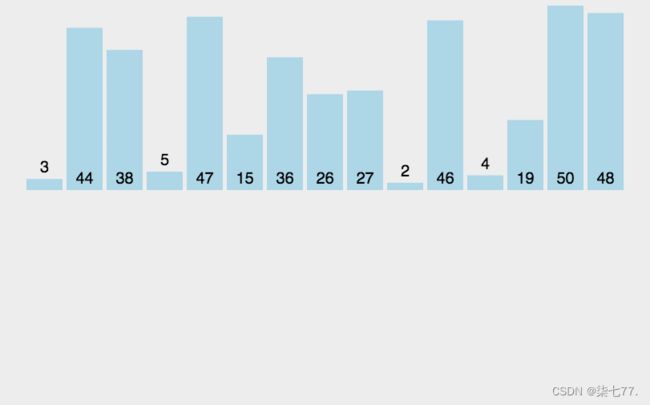python排序算法
冒泡排序
方法:多次遍历列表,比较相邻元素,不合理顺序进行交换
该算法的时间复杂度:O(n²)
 代码清单1-1:
代码清单1-1:
def bubbleSort(alist):
for passnum in range(len(alist)-1,0,-1):
for i in range(passnum):
if alist[i] > alist[i+1]:
temp = alist[i]
alist[i] = alist[i+1]
alist[i+1] = temp
可以修改算法,使其在识别到一轮遍历中没有发生元素交换(即列表已经有序)时终止循环
代码清单1-2:
def bubbleSort(alist):
exchanges = True
passnum = len(alist)-1
while passnum > 0 and exchanges:
exchanges = False
for i in range(passnum):
if alist[i] > alist[i+1]:
exchanges = True
temp = alist[i]
alist[i] = alist[i+1]
alist[i+1] = temp
passnum = passnum -1
选择排序

在未排序序列中找到最小(大)元素,存放到排序序列的起始位置,
然后再从剩余未排序元素中继续寻找最小(大)元素,放到已排序序列的末尾。
以此类推,直到所有元素均排序完毕。
代码清单1-3:
def selectionSort(alist):
for fillslot in range(len(alist)-1,0,-1):
positionOfMax = 0
for location in range(1,fillslot+1):
if alist[location] > alist[positionOfMax]:
positionOfMax = location
temp = alist[fillslot]
alist[fillslot] = alist[positionOfMax]
alist[positionOfMax] = temp
插入排序
构建有序序列,对于未排序数据,在已排序序列中从后向前扫描,找到相应位置并插入。

代码清单1-4:
def insertionSort(alist):
for index in range(1,len(alist)):
currentvalue = alist[index]
position = index
while position > 0 and alist[position-1] > currentvalue:
alist[position] = alist[position-1]
position = position-1
alist[position] = currentvalue
希尔排序
特点: 非稳定排序算法

希尔排序的基本思想是:先将整个待排序的记录序列分割成为若干子序列分别进行直接插入排序,待整个序列中的记录"基本有序"时,再对全体记录进行依次直接插入排序。
代码清单1-5:
def shellSort(alist):
sublistcount = len(alist) // 2
while sublistcount > 0:
for startposition in range(sublistcount):
gapInsertionSort(alist,startposition,sublistcount)
print("After increments of size",sublistcount,
"The list is",alist)
sublistcount = sublistcount // 2
def gapInsertionSort(alist,start,gap):
for i in range(start+gap,len(alist),gap):
currentvalue = alist[i]
position = i
while position >= gap and \
alist[position-gap] > currentvalue:
alist[position] = alist[position-gap]
position = position-gap
alist[position] = currentvalue
归并排序
 分治法:
分治法:
分割:递归地把当前序列平均分割成两半
集成:在保持元素顺序的同时将上一步得到的子序列集成到一起(归并)
代码清单1-6:
def mergeSort(alist):
print("Splitting",alist)
if len(alist) > 1:
mid = len(alist) // 2
lefthalf = alist[:mid]
righthalf = alist[mid:]
mergeSort(lefthalf)
mergeSort(righthalf)
i = 0
j = 0
k = 0
while i < len(lefthalf) and j < len(righthalf):
if lefthalf[i] < righthalf[j]:
alist[k] = lefthalf[i]
i = i + 1
else:
alist[k] = righthalf[j]
j = j + 1
k = k + 1
while i < len(lefthalf):
alist[k] = lefthalf[i]
i = i + 1
k = k + 1
while j < len(righthalf):
alist[k] = righthalf[j]
j = j + 1
k = k + 1
print("Merging",alist)
快速排序
快速排序使用分治法策略来把一个序列分为较小和较大的2个子序列,然后递归地排序两个子序列。
步骤为:
挑选基准值:从数列中挑出一个元素,称为"基准"
分割:重新排序数列,所有比基准值小的元素摆放在基准前面,所有比基准值大的元素摆在基准后面(与基准值相等的数可以到任何一边)。在这个分割结束之后,对基准值的排序就已经完成;
递归排序子序列:递归地将小于基准值元素的子序列和大于基准值元素的子序列排序。
递归到最底部的判断条件是数列的大小是零或一,此时该数列显然已经有序。 选取基准值有数种具体方法,此选取方法对排序的时间性能有决定性影响。
代码清单1-7:
def quickSort(alist):
quickSortHelper(alist,0,len(alist)-1)
def quickSortHelper(alist,first,last):
if first < last:
splitpoint = partition(alist,first,last)
quickSortHelper(alist,first,splitpoint-1)
quickSortHelper(alist,splitpoint-1,last)
def partition(alist,first,last):
pivotvalue = alist[first]
leftmark = first + 1
rightmark = last
done = False
while not done:
while leftmark <= rightmark and \
alist[leftmark] <= pivotvalue:
leftmark = leftmark + 1
while alist[rightmark] >= pivotvalue and \
rightmark >= leftmark:
rightmark = rightmark - 1
if rightmark < leftmark:
done = True
else:
temp = alist[leftmark]
alist[leftmark] = alist[rightmark]
alist[rightmark] = temp
temp = alist[first]
alist[first] = alist[rightmark]
alist[rightmark] = temp
return rightmark
